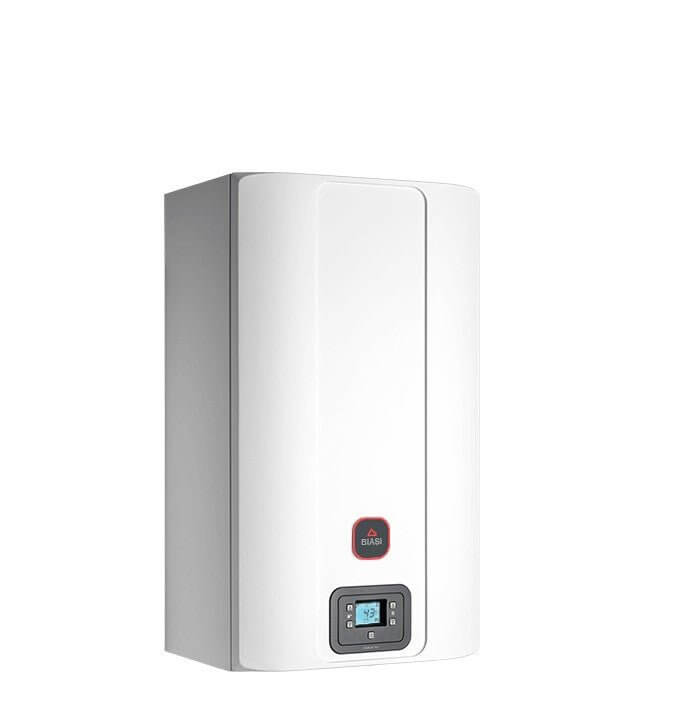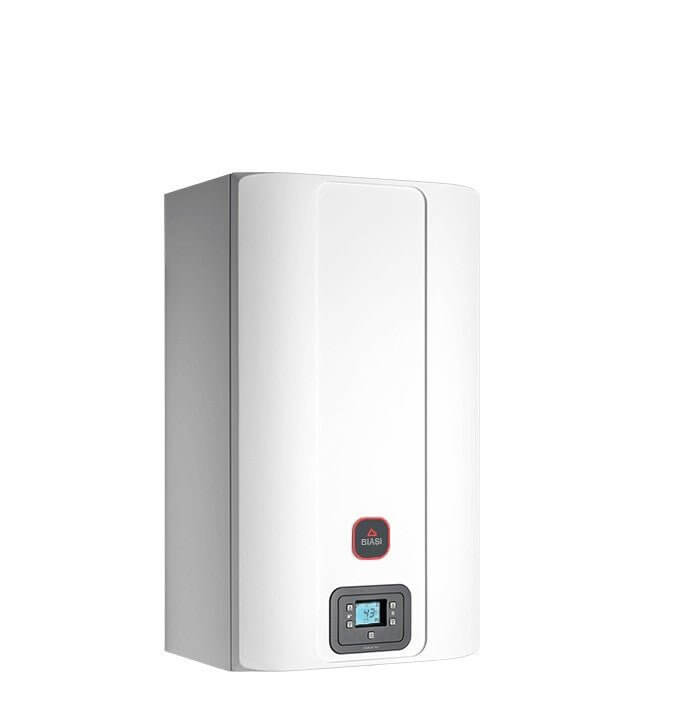Biasi Renew Adaptive 25s Low Nox Condensing Boiler Complete With Methane Or LPG / LPG Fume Exhaust Kit
Biasi Renew Adaptive 25s Low Nox Condensing Boiler Complete With Methane Or LPG / LPG Fume Exhaust Kit - Coaxial smoke kit is backordered and will ship as soon as it is back in stock.
Couldn't load pickup availability
Come funziona la spedizione
Come funziona la spedizione
I costi di spedizione variano a seconda del peso e della modalità di spedizione dell'ordine.
I nostri servizi di spedizione:
- Spedizione standard: consegna stimata dai 2 ai 5 giorni lavorativi
- Spedizione Premium: consegna garantita in 24 ore lavorative
- Spedizione Premium + Consegna al piano: consegna garantita in 24 ore lavorative
Consulta le tabelle per i prezzi della spedizione standard per l'Italia e per le Isole Minori e Zone Disagiate.
Per ulteriori dettagli sulla Spedizione Premium, consulta la pagina di spedizione premium.
Servizio clienti
Servizio clienti
Il nostro servizio di assistenza è dedicato a fornire supporto ai nostri clienti per qualsiasi problema o domanda che possano avere prima o dopo l’acquisto dei nostri prodotti.
Utilizza il canale di comunicazione diretta per parlare con un nostro operatore, oppure inviaci una mail ad uno degli indirizzi elencati nella pagina contattaci.
Il nostro team di assistenza clienti è composto da professionisti altamente qualificati e sempre pronti ad aiutare i clienti a risolvere qualsiasi problema o rispondere a qualsiasi domanda in modo rapido ed efficiente. Ci impegniamo a garantire la massima soddisfazione del cliente e a fornire un servizio di assistenza post-vendita di altissima qualità. Quindi, se hai bisogno di assistenza, non esitare a contattarci; saremo lieti di aiutarti in ogni modo possibile.
Description
Description
Biasi rinNova adaptive 25s low NOx condensing boiler complete with methane or LPG fume exhaust kit
- Heating/DHW nominal heat input kW 21.0 / 26.0
- Heating/DHW minimum heat input kW 3.0 / 3.0
- Heating/DHW maximum useful power 60°/80°C * kW 20.7 / 25.6
- Heating/DHW minimum useful power 60°/80°C * kW 2.8 / 2.8
- Heating/DHW maximum useful power 30°/50°C ** kW 22.8 / 28.2
- Heating/DHW minimum useful power 30°/50°C ** kW 3.2 / 3.2
- Yield name 60°/80°C * % 98.4
- Yield min. 60°/80°C * % 94.0
- Yield name 30°/50°C ** % 108.6
- Yield min. 30°/50°C ** % 105.2
- NOx class 6
- Minimum/maximum heating pressure bar 0.3 / 3
- Expansion tank capacity (total/useful) l 7
- Maximum flow rate (ΔT=25 K) / (ΔT=35 K) l/min 15.4 / 10.7
- Specific sanitary flow rate (ΔT=30 K) ***** l/min 12.8
- Voltage/Power at nominal heat input V~/ W 230 / 100
- Power at minimum thermal capacity W 52
- Degree of protection IPX5D
- Height x Width x Depth mm 700 x 400 x 300
- Weight kg 31.5
- Boiler water content 2.0 l
- Code 20312.0221.0
RinNova adaptive
The RinNova Adaptive condensing boiler , unlike traditional boilers, allows you to recover energy by condensing the water vapor contained in the exhaust fumes; that is, for the same amount of heat produced, it consumes less gas and furthermore the exhaust fumes contain fewer substances which are harmful to the environment. The materials that compose it and the regulation systems with which it is equipped offer safety, high comfort and energy savings, so as to be able to fully appreciate the advantages of autonomous heating.
RinNova Adaptive is the new BIASI model of wall-mounted condensing boiler .
It offers excellent performance and high yields that last over time, thanks to the innovative heat exchanger . Simple to use thanks to the digital control panel, with a display designed to communicate with the user easily and comfortably.
Technical features
- Boiler with single circuit primary exchanger in stainless steel, without joints and/or welds, which maintains high efficiency even on older systems
- New combustion system with patented gas-adaptive technology (Advanced Adaptive Gas Combustion Control – A²GC²) The electronics continuously analyze the combustion (CO2) through the flame signal and intervene by acting on the gas valve and fan, to allow correct combustion in all terms of use. The electronics allow the boiler to be easily adapted to the various types of gas without having to intervene with a mechanical transformation kit
- Instant production of domestic hot water with dedicated plate exchanger
- Domestic hot water pre-heating function: faster delivery of domestic hot water
- User interface with display and multifunction keys for adjusting and setting the parameters
- Easy to inspect standard by-pass
- Chimney Protection System: electronic management of fume overheating, guaranteeing maximum protection of the chimney
- Ducting on flues: particularly suitable for operation in flues that require ducting with high pressure drops
- Minimum polluting emissions (class VI - EN 15502-1)
- Sliding temperature operation via optional external probe
- Low consumption modulating heating pump (ErP Ready - Class A)
- Digital flame control with three re-ignition attempts in the event of blocking due to lack of flame detection (methane configuration)
- Removable casing in three pieces for easier maintenance or inspection
- For SV versions: possibility of setting the maximum power that can be supplied to the external boiler
Gas-adaptive technology
Less consumption, more efficiency, fewer emissions
The innovative Adaptive Gas technology, which all models in the Rinnova line are equipped with, allows the boilers to be adapted in complete autonomy to the different types and qualities of gas. The electrode, in addition to detecting the flame, also detects the characteristics of the gas and automatically adapts the combustion parameters to maintain the maximum level of efficiency, with a consequent reduction in consumption and emissions compared to traditional control systems. The Adaptive gas system makes the boiler ready to operate with any type of gas without transformations.
- Automatic gas regulation
- Adaptation to changing gas quality
- Clean combustion
- The only model suitable for methane and LPG which allows you to optimize the warehouse
- In traditional boilers, the combustion values are detected and adjusted only during maintenance, furthermore the composition of the gas network is not always constant and can create operating inefficiencies on boilers without combustion control devices, compromising reliability, savings and the quality of emissions.
- Thanks to the Gas-Adaptive system, the new condensing boilers electronically control combustion by managing the gas and air supply at best and at all times, automatically adapting the CO2.
A "Plastic-FREE" production
For a more sustainable environment
A fundamental element that guided the entire design phase of the new Rinnova Adaptive boiler is the strong focus on the circular economy. For this we have used components with a higher rate of recyclability, eliminating the use of plastic as much as possible. The plastic group, for example, has been replaced with the brass group, a completely recyclable material. The protective shells of the boiler were made of cardboard and no longer of polystyrene. Furthermore, the front is no longer in plastic but in pressed steel.
Thermoregulation
Climatic regulation (with optional external probe) and ambient regulation (remote) to allow correct management of the water temperature in order to reduce consumption and consequently a reduction in emissions.
By using the climatic regulation, the regulation efficiency also rises, giving greater value to the home.
High circulation single coil primary heat exchanger
Biasi, introduces the Round heat exchanger in 2017. The great reliability has been demonstrated by adopting it in the Renew Adaptive range. Round is a compact monothermal heat exchanger based on a stainless steel coil with an oval section.
The heat exchanger consists of a combustion chamber, condensing area and an insulated metal disc protected with silicone ceramic fiber which separates the two areas.
By using a single stainless steel strip to produce the coil, including inlet/outlet fittings, the following benefits are achieved:
- Accumulation of dirt and debris is avoided
- The water flow is uniformly distributed and guarantees a homogeneous heat exchange
- The water flow is constant for a longer life of the product
- Reduction of pressure drops with optimized circuit
- The ease of cleaning and the robustness of this exchanger are one of the main strengths of the product since it can be used on new systems but also on old systems in the event of renovations.
Round integrates the round flow function in which the water produces a centrifugal cleaning effect on the internal walls of the single coil. The absence of circuits in parallel guarantees an easy "washing" operation of the exchanger and the elimination of any air present in the system circuit.
Warranty All products for sale on our site are new and packed. The warranty on this item is 24 months from the date of purchase.
Scheda Tecnica
Scheda Tecnica
- peso: 50.0 kg
- classe energetica produzione acs: A
- classe energetica riscaldamento: A
- gas: Methane/LPG
- marca: Blame
- metri quadri : 250
- modello: 20312.0221.0
- potenza in kw: 35
- potenza nominale: 35
- superficie riscaldabile mq: 250




